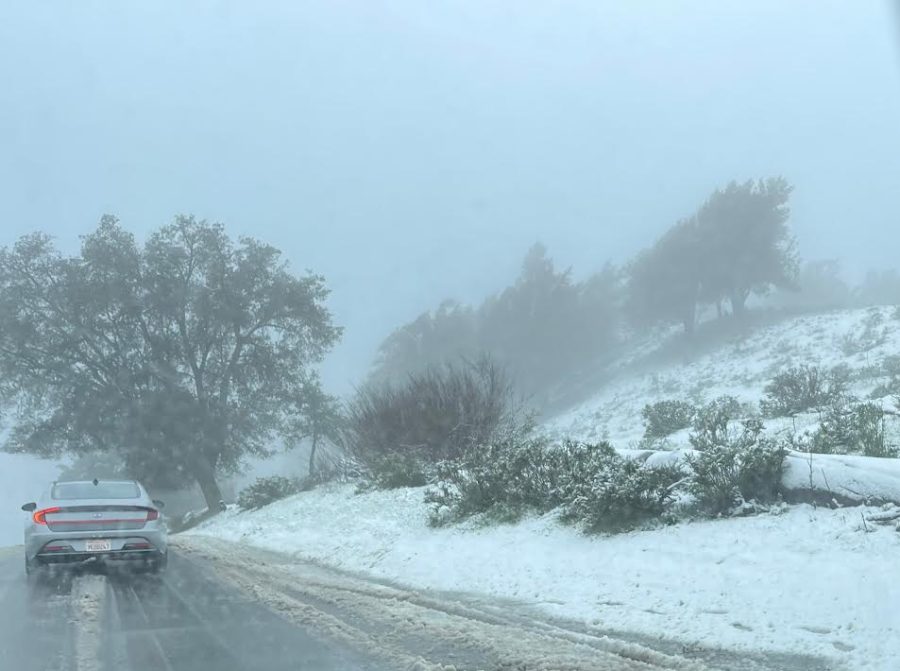The recent Bay Area snowstorm highlighted the worsening local effects of climate change.
On Friday, Feb. 24, the National Weather Service issued a Winter Weather Warning and forecasted small amounts of snow in the surrounding Bay Area.
This prompted many local Bay Area residents to see the snow that fell in places like Mt. Tamalpais or along Skyline Boulevard in Woodside. Jamie Bikle was just one of the locals to experience the snowfall first-hand.
“It was pretty cool to see snow outside my house, we woke up, and our deck and whole yard were covered in snow; it was a lot of fun,” Bikle said.
Combined with the earlier New Year’s Eve rain storms, these events made this winter one of the coldest in 30 years, with average temperatures in Bay Area cities like Oakland remaining below 50 degrees Fahrenheit.
While the snowfall generated excitement among Bay Area residents, several climate change activists maintain that these uncharacteristic storms are likely partially the result of climate change.
The snowfall level in the recent storm was as low as 400 feet in parts of California such as Sonoma County. Laura Neish, a worker for the climate-oriented nonprofit organization 350 Bay Area, explained the cause of the lower-elevation snowfall and cold temperatures.
“As predicted by the climate models, higher average temperatures disrupt and weaken the Gulf Stream. This means that arctic temperatures, which are currently higher than average but still really cold, are not held in their traditional far north range, so the super cold temperatures are dipping way farther south than historical norms,” Neish said.
She explained that climate change increases the odds of severe weather extremes, causing more severe droughts or alternative rain and snowstorms.
Experts from the United States Environmental Protection Agency added that other extreme weather phenomena are becoming more common in addition to snow, like droughts, floods, hurricanes, and wildfires.
Human activities like the burning of fossil fuels, the production of electricity and heat, agriculture, and transportation release greenhouse gases (GHGs) into the atmosphere that gets trapped. According to NASA, emissions of GHGs cause rising temperatures that melt ice sheets, creating more storms and affecting animal ecosystems.
“Climate change is a global problem. The international, national, and state policies to curb greenhouse gasses are vital, but the local level is just as important,” said Nate Huntington, the CivicSpark fellow at the Bay Area nonprofit Greenbelt Alliance, aimed at increasing climate resilience in local communities.
Huntington’s main role concerns the Resilience Hotspots project, which works with communities exposed to risks like fires, flooding, or excessive heat and helps them prepare for these difficulties.
For this project in Fairfield and the wider area of Solano County, Huntington is currently working with local agencies on the early stages of a sea level rise adaptation project.
He also emphasized ensuring that cities have adequate “Climate Action Plans” and follow through on their climate goals, which is more straightforward to do locally.
Other nonprofits looking to combat climate change in the Bay Area have taken slightly different approaches. They focus on strategies to mitigate carbon emissions and alter existing infrastructure, like transportation systems, to be more sustainable.
The nonprofit organization Acterra, based in Palo Alto, is helping combat climate change by partnering with several organizations and regional governments, according to their executive director, Lauren Weston.
“We promote and support electrification, energy efficiency and renewable energy, transportation innovation, food sustainability, resilience and adaptation, and sustainable business practices in our region,” Weston said.
Both organizations emphasize the importance of continuing to fight climate change and the steps that can be taken at the local level to do so.
“One major thing I want people to realize about climate change is that it takes everybody and will require a rethinking of how we organize our society at a systems level. It’s not just going to take ‘environmentalists.’ It will take people in every sector recognizing that they have a duty to protect the earth and steward it properly for future generations,” Huntington said.
Weston added that joining an organization makes it easier to make shifts happen and to know where to start.
“It’s true when trying to reduce emissions in your own life because you’re not having to reinvent the wheel, you can learn from best practices, and can build new habits when you have a community to provide support,” Weston said.
She also explained that climate change wouldn’t be solved by one person acting alone, but rather if people could work together.
“It’s important that we keep trying because we always want to be the ones working towards a solution rather than continuing to be part of the problem,” Weston said.



































